Gypsy
Super_Ideal_Rock
- Joined
- Aug 8, 2005
- Messages
- 40,225
Re: New and looking for help choosing Cushion cut diamond to
Here's some additional knowledge for you:
It is important to remember is that color is graded FACE DOWN. Where there is NO light return. Not face up where there is light return and refraction. You wear diamonds set. FACE UP.
Within one color grade, even the labs can't agree on the color grades of stones and something could be a "high" H or a "low" E. Within 2 color grades it is hard too. And it gets harder once set. If you are talking ideal rounds, or any stone with ideal light return and no sharp corners it gets harder still because the ideal light return masks body color.
Generally we say to be conservative stay above H.
If you are talking fancy shapes without ideal light return (because there is no 'ideal' for EC's Radiant, etc) it's a bit different. Shapes without points: so ovals and cushions with great ASETs are still fine down to H and very white (please note if a cushion has radiant/crushed ice faceting then G and above is safer). Shapes with points: pears, princesses, marquise... those show color more readily. So G and above. Some radiants and crushed ice radiant type faceting traps color so G and above.
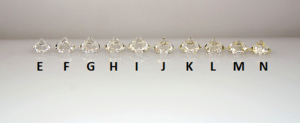
This is how I think of it.
Ever gotten one of those HUGE paint fan decks? Where there are literally 100s of colors of whites? And when they are RIGHT next to each other you can TOTALLY tell that one is bluer/colder and one is a bit warmer and which one is one is TOTALLY warmer. One there's one that's slightly greener. One that's slightly pinker? But really. They are all white?
Then you pick one after agonizing over this white or that white and when it's on the walls and people are like: Oh. You painted again. And it's STILL white. Great.
And you're all... BUT it's BLUE white. Or it's a WARM white now. It used to be ____ white. It's TOTALLY different.
It's like that. You are talking about shades of white. D is colder... J is warmer. But it's all white.
YES. If you have an accurately graded F and an H THAT HAVE THE SAME PERFORMANCE you are going to be able to tell them apart when you compare them side by side. Just like you would be able to tell if you painted your walls a warm white, but painted the crown molding a cold/straight white. But both are STILL white, you only see the contrast because of the proximity. But it's very slight, you could set an F center with G sides and never tell the difference. And even H sides depending on the setting and the size of the sidestones... especially with round brilliants.
I want you notice all the qualifiers thought. I'm talking about stones with the SAME performance. An ideal H will out white an F that has compromised light performance from a poor cut.
NOTHING impacts the appearance of a diamond as much as cut. CUT is king.
You want the shinest whitest and brightest diamond out there: Cut is King. No other factor, not color or clarity or anything else impacts how white bright an shiny a stone is.
Here's some additional knowledge for you:
It is important to remember is that color is graded FACE DOWN. Where there is NO light return. Not face up where there is light return and refraction. You wear diamonds set. FACE UP.
Within one color grade, even the labs can't agree on the color grades of stones and something could be a "high" H or a "low" E. Within 2 color grades it is hard too. And it gets harder once set. If you are talking ideal rounds, or any stone with ideal light return and no sharp corners it gets harder still because the ideal light return masks body color.
Generally we say to be conservative stay above H.
If you are talking fancy shapes without ideal light return (because there is no 'ideal' for EC's Radiant, etc) it's a bit different. Shapes without points: so ovals and cushions with great ASETs are still fine down to H and very white (please note if a cushion has radiant/crushed ice faceting then G and above is safer). Shapes with points: pears, princesses, marquise... those show color more readily. So G and above. Some radiants and crushed ice radiant type faceting traps color so G and above.

This is how I think of it.
Ever gotten one of those HUGE paint fan decks? Where there are literally 100s of colors of whites? And when they are RIGHT next to each other you can TOTALLY tell that one is bluer/colder and one is a bit warmer and which one is one is TOTALLY warmer. One there's one that's slightly greener. One that's slightly pinker? But really. They are all white?
Then you pick one after agonizing over this white or that white and when it's on the walls and people are like: Oh. You painted again. And it's STILL white. Great.
And you're all... BUT it's BLUE white. Or it's a WARM white now. It used to be ____ white. It's TOTALLY different.
It's like that. You are talking about shades of white. D is colder... J is warmer. But it's all white.
YES. If you have an accurately graded F and an H THAT HAVE THE SAME PERFORMANCE you are going to be able to tell them apart when you compare them side by side. Just like you would be able to tell if you painted your walls a warm white, but painted the crown molding a cold/straight white. But both are STILL white, you only see the contrast because of the proximity. But it's very slight, you could set an F center with G sides and never tell the difference. And even H sides depending on the setting and the size of the sidestones... especially with round brilliants.
I want you notice all the qualifiers thought. I'm talking about stones with the SAME performance. An ideal H will out white an F that has compromised light performance from a poor cut.
NOTHING impacts the appearance of a diamond as much as cut. CUT is king.
You want the shinest whitest and brightest diamond out there: Cut is King. No other factor, not color or clarity or anything else impacts how white bright an shiny a stone is.

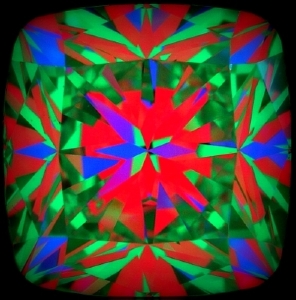
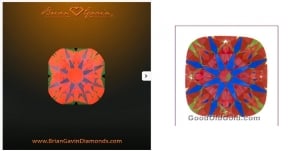
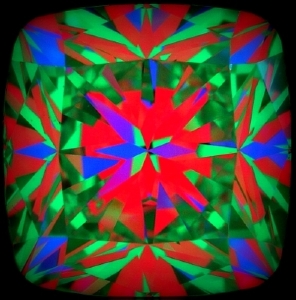
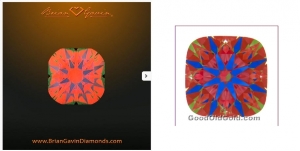
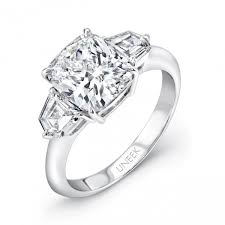


300x240.png)